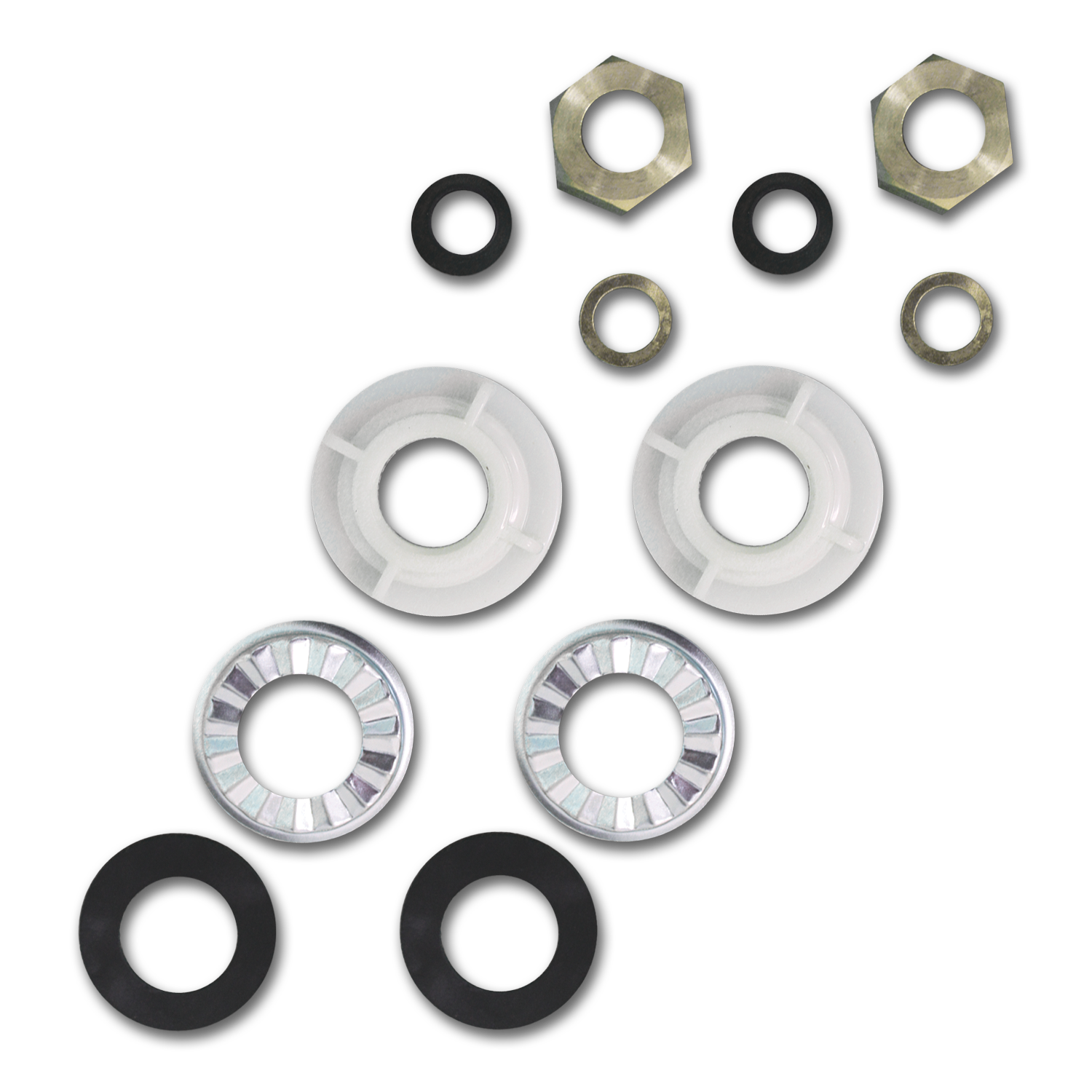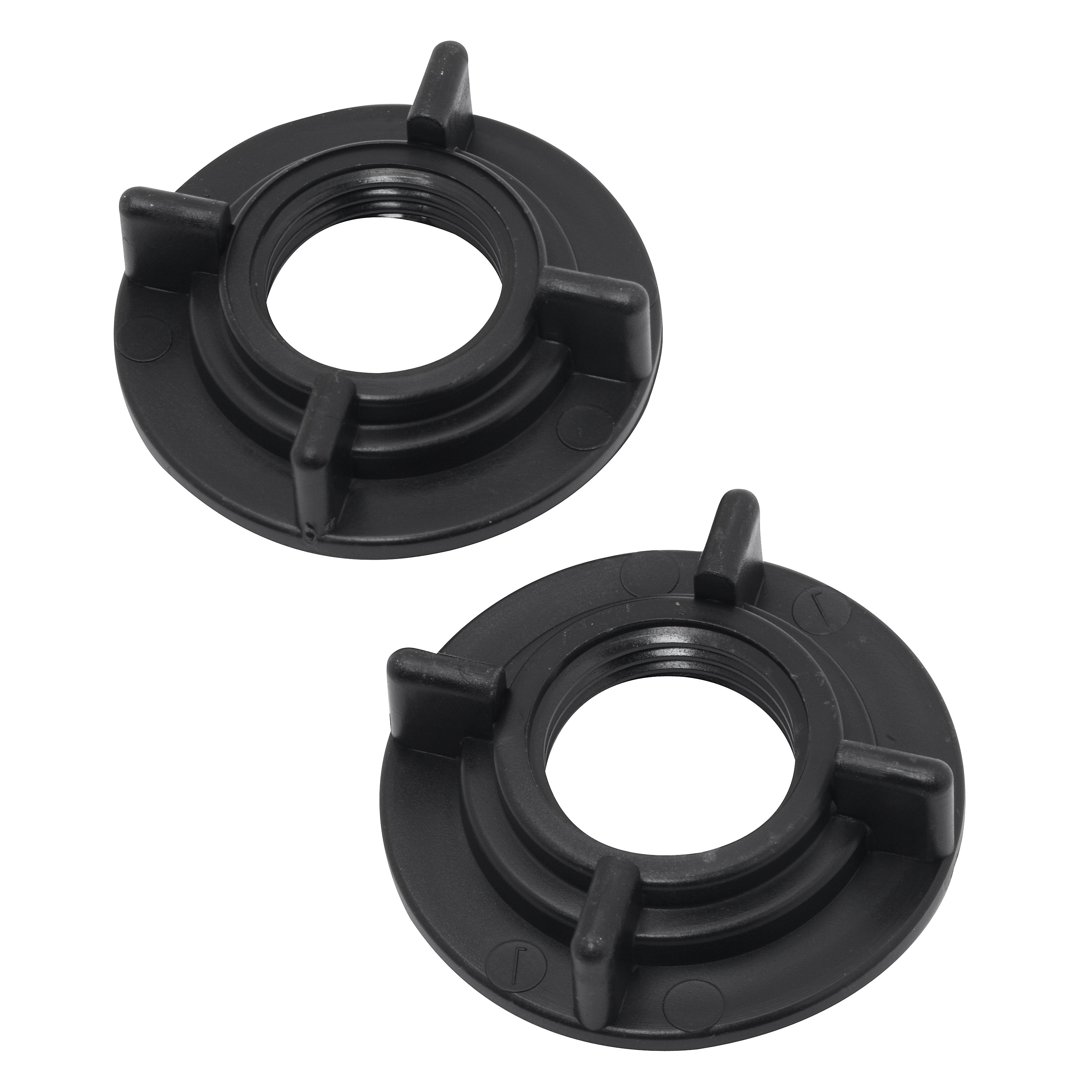Understanding Bathroom Faucet Mounting Nuts
Bathroom faucet mounting nuts are essential components that secure the faucet to the sink or countertop. These nuts are typically hidden beneath the faucet, but they play a crucial role in ensuring the stability and watertight seal of the faucet.
Types of Bathroom Faucet Mounting Nuts
The type of mounting nut used depends on the style and design of the faucet. Here’s a breakdown of common types:
- Standard Mounting Nuts: These are the most common type and are typically used for single-handle and two-handle faucets. They feature a threaded hole that fits onto the faucet’s threaded stem and a flat surface that rests against the sink or countertop.
- Deck Mounting Nuts: These nuts are used for faucets that are mounted on the countertop, rather than directly to the sink. They typically have a larger diameter than standard mounting nuts and are designed to provide extra stability.
- Wall Mounting Nuts: These nuts are used for faucets that are mounted to the wall. They are typically larger and more robust than standard mounting nuts and are designed to withstand the weight of the faucet.
- Compression Mounting Nuts: These nuts are used for faucets that have a compression-style installation. They feature a threaded sleeve that compresses against the faucet’s stem to create a tight seal.
- Expansion Mounting Nuts: These nuts are used for faucets that have an expansion-style installation. They feature a threaded sleeve that expands outward to create a tight seal against the sink or countertop.
Materials Used for Bathroom Faucet Mounting Nuts
Bathroom faucet mounting nuts are typically made from brass, stainless steel, or plastic.
- Brass: Brass is a durable and corrosion-resistant material that is commonly used for mounting nuts. It is also relatively affordable, making it a popular choice for manufacturers.
- Stainless Steel: Stainless steel is even more durable and corrosion-resistant than brass. It is also resistant to rust and stains, making it a good choice for areas with high humidity. However, stainless steel is more expensive than brass.
- Plastic: Plastic mounting nuts are typically used for less expensive faucets. They are lightweight and easy to install, but they are not as durable as brass or stainless steel.
Installation Process and Considerations

Installing a bathroom faucet with mounting nuts is a straightforward process that requires some basic tools and careful attention to detail. Understanding the steps involved and common mistakes will ensure a smooth and successful installation.
Tools Required for Installation
A set of appropriate tools is essential for a successful installation. The following table Artikels the tools needed:
| Tool | Description |
|---|---|
| Adjustable Wrench | Used to tighten and loosen nuts and fittings. |
| Channel-Lock Pliers | Provide a secure grip for tightening and loosening nuts. |
| Plumber’s Tape | Used to seal threaded connections and prevent leaks. |
| Level | Ensures the faucet is installed straight and level. |
| Screwdriver | Used to secure the faucet to the countertop or sink. |
Steps Involved in Installing a Bathroom Faucet
- Turn Off the Water Supply: Locate the shut-off valves for the hot and cold water lines and turn them off completely. This prevents water from flowing during the installation process.
- Remove the Old Faucet: Unscrew the old faucet’s mounting nuts and remove the faucet from the sink or countertop. Be careful not to damage the sink or countertop during removal.
- Clean the Installation Area: Remove any debris or old sealant from the installation area on the sink or countertop. Ensure the surface is clean and free of obstructions.
- Connect the Water Lines: Connect the new faucet’s water lines to the hot and cold water supply lines. Use plumber’s tape to seal the threaded connections and prevent leaks.
- Position the Faucet: Position the new faucet on the sink or countertop, ensuring it is centered and level. Use the level to check for accuracy.
- Install the Mounting Nuts: Tighten the mounting nuts onto the faucet’s base, securing it to the sink or countertop. Ensure the nuts are evenly tightened to avoid leaks or damage to the faucet.
- Test for Leaks: Turn the water supply back on and check for leaks around the faucet base and water lines. If any leaks are found, tighten the connections or re-apply plumber’s tape.
Common Installation Mistakes and How to Avoid Them
- Over-tightening the Mounting Nuts: Over-tightening can damage the faucet or the sink/countertop. Ensure the nuts are tightened securely but not excessively.
- Not Using Plumber’s Tape: This can lead to leaks at the threaded connections. Apply plumber’s tape to all threaded connections to ensure a secure seal.
- Incorrect Faucet Placement: Ensure the faucet is centered and level on the sink or countertop. Using a level will help achieve accurate placement.
- Not Checking for Leaks: Failing to check for leaks after installation can lead to future problems. Thoroughly test for leaks after turning the water supply back on.
Choosing the Right Mounting Nuts
Selecting the appropriate mounting nuts is crucial for ensuring a secure and leak-proof installation of your bathroom faucet. The mounting nuts are responsible for attaching the faucet body to the sink or countertop, so choosing the right size and thread type is essential.
Factors to Consider When Selecting Mounting Nuts, Bathroom faucet mounting nuts
The selection of mounting nuts for your bathroom faucet should be based on several factors, including:
- Faucet Model and Type: Different faucet models have varying mounting configurations. For example, single-hole faucets typically use one large mounting nut, while widespread faucets may use two smaller nuts.
- Sink or Countertop Material: The material of your sink or countertop can affect the type of mounting nut you need. Some materials, like granite or marble, may require special mounting nuts to prevent damage.
- Faucet Installation Method: Depending on the installation method, you may need different types of mounting nuts. For example, deck-mounted faucets require different nuts than wall-mounted faucets.
- Faucet Brand and Model: Different faucet brands and models may have specific mounting nut requirements. It is always best to consult the manufacturer’s instructions or website for the recommended mounting nuts.
Identifying Compatible Mounting Nuts
To identify the compatible mounting nuts for your faucet, you can refer to the following methods:
- Check the Manufacturer’s Instructions: The manufacturer’s instructions will typically specify the required mounting nut size, thread type, and any other relevant information.
- Refer to the Faucet’s Specifications: You can find the mounting nut specifications in the faucet’s technical data sheet or on the manufacturer’s website.
- Measure the Existing Mounting Nuts: If you are replacing an existing faucet, you can measure the size and thread type of the old mounting nuts to find compatible replacements.
Maintenance and Troubleshooting

While bathroom faucet mounting nuts are generally robust and long-lasting, regular maintenance and proper troubleshooting can help extend their lifespan and prevent potential issues.
Routine Maintenance
Regular maintenance of bathroom faucet mounting nuts is crucial for ensuring their smooth operation and preventing premature wear and tear. Here are some essential practices:
- Inspect for Loose Nuts: Periodically check for any loose mounting nuts, which can cause leaks and instability. Tighten them gently using a wrench or pliers to ensure a secure fit.
- Clean and Lubricate: Clean the mounting nuts and threads with a mild detergent and a soft cloth to remove any debris or buildup. Apply a thin layer of silicone grease or lubricant to the threads to prevent corrosion and facilitate smooth turning.
- Check for Corrosion: Inspect the mounting nuts for signs of corrosion, which can weaken the metal and lead to failure. If you notice any corrosion, replace the affected nuts immediately.
Common Problems and Solutions
Common problems associated with bathroom faucet mounting nuts can be easily addressed with the right knowledge and tools. Here are some common issues and their solutions:
- Leaky Faucet: A leaky faucet is often a sign of loose or worn-out mounting nuts. Tighten the nuts securely, and if the leak persists, replace the nuts or the entire faucet cartridge.
- Stripped Threads: Stripped threads can occur due to overtightening or corrosion. Replacing the mounting nuts with new ones is the most effective solution.
- Faucet Wobble: A wobbly faucet indicates loose mounting nuts or a worn-out faucet base. Tighten the nuts, and if the wobble persists, replace the faucet base or the entire faucet.
Troubleshooting Mounting Nut Issues
Troubleshooting issues related to bathroom faucet mounting nuts involves a systematic approach to identify the root cause and implement the appropriate solution. Here’s a step-by-step guide:
- Identify the Problem: Determine the specific issue you’re facing, such as a leaky faucet, stripped threads, or a wobbly faucet.
- Inspect the Mounting Nuts: Carefully examine the mounting nuts for any signs of looseness, corrosion, or stripped threads.
- Tighten the Nuts: If the nuts are loose, gently tighten them using a wrench or pliers. Ensure you don’t overtighten, as this can damage the threads.
- Clean and Lubricate: If the problem persists, clean the mounting nuts and threads with a mild detergent and a soft cloth. Apply a thin layer of silicone grease or lubricant to the threads to prevent corrosion and facilitate smooth turning.
- Replace the Nuts: If the nuts are corroded or have stripped threads, replace them with new ones. Ensure the new nuts are compatible with your faucet model.
- Replace the Faucet Base: If the problem is related to a worn-out faucet base, consider replacing the entire faucet base or the entire faucet.
Safety and Best Practices: Bathroom Faucet Mounting Nuts

Installing and maintaining bathroom faucet mounting nuts requires a cautious approach to prevent accidents and ensure a secure and long-lasting installation. It’s crucial to prioritize safety throughout the process, from preparing the work area to handling tools and components.
Safety Precautions During Installation and Maintenance
Safety precautions are paramount when working with bathroom faucet mounting nuts. Here’s a checklist of essential safety measures to follow:
- Turn off the water supply: Before disassembling or installing any faucet components, always turn off the water supply to the bathroom. This prevents accidental water leaks and potential injuries.
- Use appropriate tools: Employ the correct tools for the job, such as adjustable wrenches, pliers, and screwdrivers, to avoid damaging the faucet or causing injury.
- Wear safety glasses: Protect your eyes from flying debris or water splashes by wearing safety glasses.
- Use gloves: Wear gloves to prevent skin irritation or cuts from sharp edges.
- Work in a well-lit area: Ensure adequate lighting to see clearly and avoid mistakes during installation or maintenance.
- Be cautious of sharp edges: Be mindful of sharp edges on the faucet and tools, and handle them with care to prevent cuts.
- Use a ladder safely: If you need to reach high areas, use a stable ladder and follow all safety guidelines for ladder use.
Potential Hazards of Improper Installation or Maintenance
Neglecting safety measures during installation or maintenance can lead to several hazards:
- Water leaks: Improperly installed mounting nuts can cause leaks, leading to water damage, mold growth, and potential electrical hazards.
- Faucet damage: Using the wrong tools or excessive force can damage the faucet, requiring costly repairs or replacements.
- Personal injury: Improper handling of tools, sharp edges, or falling objects can result in cuts, scrapes, or more serious injuries.
“Prioritizing safety is essential when working with bathroom faucet mounting nuts. By following the safety precautions Artikeld above, you can minimize the risk of accidents and ensure a successful installation or maintenance process.”
